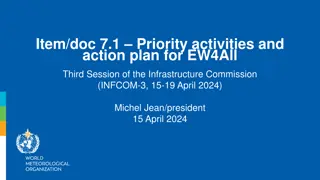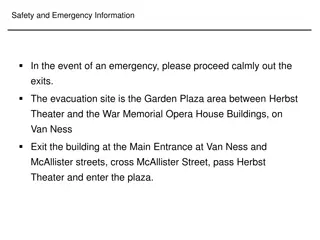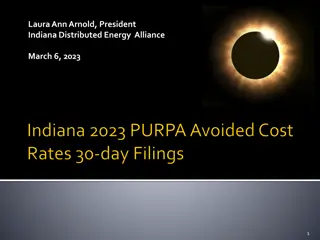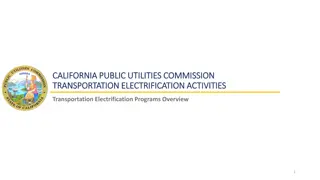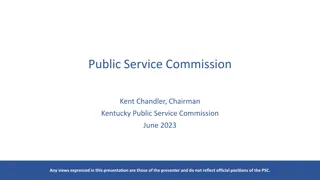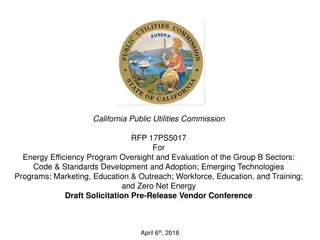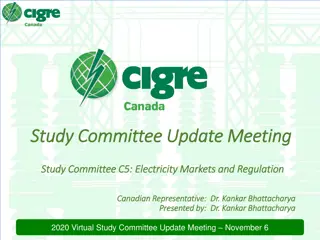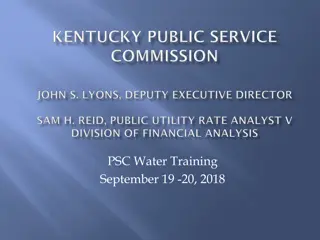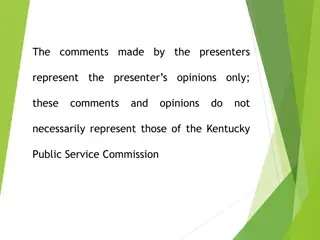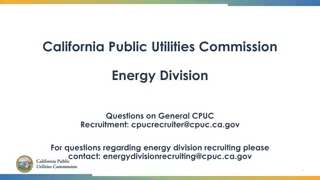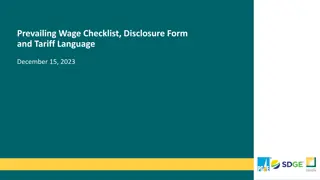California Public Utilities Commission's Distributed Energy Resources Action Plan
The Distributed Energy Resources (DER) Action Plan by the California Public Utilities Commission (CPUC) lays out a vision and framework for DER policy development and implementation. The plan encompasses three tracks focusing on rates and tariffs, distribution grid infrastructure, and wholesale DER market integration. It aims to promote customer choice, innovative rates, transparent planning, and robust DER participation in wholesale markets. The plan serves as a living document to guide CPUC actions and coordination across relevant proceedings.
Download Presentation

Please find below an Image/Link to download the presentation.
The content on the website is provided AS IS for your information and personal use only. It may not be sold, licensed, or shared on other websites without obtaining consent from the author.If you encounter any issues during the download, it is possible that the publisher has removed the file from their server.
You are allowed to download the files provided on this website for personal or commercial use, subject to the condition that they are used lawfully. All files are the property of their respective owners.
The content on the website is provided AS IS for your information and personal use only. It may not be sold, licensed, or shared on other websites without obtaining consent from the author.
E N D
Presentation Transcript
DISTRIBUTED ENERGY RESOURCES ACTION PLAN California Public Utilities Commission LSI Conference on Electric Power and Project Financing in CA November 2, 2017 Simon Baker Deputy Director, Energy Division, CPUC
DER Action Plan Overview Endorsed by CPUC Commissioners in November 2016 The DER Action Plan is a brief document that: Sets a long-term vision for DERs and supporting polices Identifies CPUC actions needed to meet that vision Establishes a coordinating framework across implicated CPUC proceedings Publicly available on CPUC website at http://www.cpuc.ca.gov/picker/ 2
DER Action Plan Implementation Guides development and implementation of DER policy across 15 CPUC proceedings and 2 CAISO stakeholder initiatives Does not determine outcomes of individual proceedings Provides a platform for common understanding of the direction the CPUC intends for DER policy to take Stimulates coordination across proceedings on priority issues Living document 3
DER Action Plan Structure 17 Vision Elements and 35 Action Elements grouped into 3 tracks: Track 1: Rates and Tariffs Track 2: Distribution Grid Infrastructure, Planning, Interconnection, and Procurement Track 3: Wholesale DER Market Integration and Interconnection 4
Track 1: Rates and Tariffs Vision Customer choice Time varying rates Innovative rates and tariffs Aligned with cost causation Affordable to non-DER customers 5
Track 2: Distribution Planning, Infrastructure, Interconnection, and Procurement Vision Transparent planning and sourcing Utility 2.0 / IOU business model Technology-neutral sourcing Recognize full GHG and grid services value Streamlined interconnection DER-enabling grid investments for ratepayer benefit Data communications and cybersecurity 6
Track 3: Wholesale DER Market Integration and Interconnection Vision Robust DER participation in wholesale markets Multiple revenue streams Market and interconnection rules supportive of BTM DERs Predictable EV behavior in grid operations Non-discriminatory market rules for EVs 7
Early Accomplishments DER Action Plan referenced in the record of five proceedings (DR, Storage, Rule 21, SCE RDW, EE) Updated CPUC Commissioners briefed at Jul 2017 Emerging Trends Committee meeting Referenced in trade press Precipitating movement on non-residential rate reform (Actions 1.9, 1.10) Mappedtiming of handoffs from DRP, IDER, and Residential RDWs to NEM Revisit in 2019 (Action 1.12) 8
Example: Timing of Handoffs to NEM Revisit Caveat: Staff Conceptual Timeline based on Status Quo Procedural Approach 9
DER Action Plan STATUS UPDATES 10
Action Element Status Snapshot (as presented to Commissioners at July 12 Emerging Trends Meeting) Track 1: Rates and Tariffs Done Track 2: Distribution Grid Infrastructure, Planning, Interconnection, and Procurement Underway Pending* *Pending elements are either waiting on another task or have not yet been started. Track 3: Wholesale DER Market Integration and Interconnection 11
Status Update Track 1: Rates and Tariffs TOU Periods (Actions 1.1, 1.7) D.17-01-006 adopted policy guidelines for setting TOU periods (grandfathering rules, menu of rate options), in collaboration with CAISO Residential TOU (Actions 1.2, 1.8, 1.11) Opt-in pilots (2016-17) approved and underway Default pilots (2018) approved. General Rate Cases (Actions 1.3, 1.9) D.17-08-030 in SDG&E GRC2 approves late-shift of TOU peak (to 3-9PM), new daytime super off-peak period during spring months, and demand charge reforms. Pending PG&E GRC2 (A.16-06-013) and SCE GRC2 (A.17-06- 030) cases have similar issues in scope. 12
Status Update Track 1: Rates and Tariffs (cont d) Rate design to absorb renewables (Action 1.4) Residential opt-in TOU pilots (PG&E / SCE Rate 3) D.17-08-030 in SDG&E GRC2 - Daytime super off-peak (weekday Mar-Apr 10-2), demand charge exemption rate option during Mar-Apr super off-peak window IOUs matinee pricing pilots rejected or withdrawn in lieu of broader rate changes Net Energy Metering (NEM) successor Disadvantaged Community alternative (Action 1.5) Under consideration in R.14-07-002 Rate forum to consider innovative tariffs and rates (Action 1.10) Workshop planned for Dec 2017 13
Status Update Track 1: Rates and Tariffs (cont d) Analytical tools to support 2019 NEM revisit (Action 1.12) D.17-09-026 approved locational value methods in the DRP proceeding. Expect Q2 2018 decision to further refine. Implementation over the coming year. Marketing, Education and Outreach plans (Action 1.13) Draft resolution approving PG&E plan on 11/9 Commission agenda. Other IOUs imminent. Meet statutory requirements for default residential TOU rates (Action 1.14) D.17-09-036 made findings required per P.U. Code Section 745 re: potentially vulnerable customers 14
Status Update Track 2: Distribution Grid Progress in DRP Proceeding (R.14-08-013) (Actions 2.1 et al., 2.5, 2.8 & 2.9) D.17-02-007 and D.17-06-012 approved IOUs demonstration pilots All IOUs pilots to prove-out locational benefits ( Demo C ) PG&E and SCE pilots to on grid operations at high DER penetration ( Demo D ) SDG&E and SCE micro-gridpilots ( Demo E ) D.17-09-026 approved locational value and hosting capacity methods PD pending on distribution deferral framework, grid modernization. (SCE $2.3B grid modernization request under consideration in A. 16-09-001.) Progress in Integrated Distributed Energy Resources (R.14- 10-003) (Action 2.2 et al.) D.16-12-036 approved competitive solicitation and shareholder incentive pilot for DER provision of distribution grid services. Draft resolution E-4889 on 11/30 agenda. D.16-06-007 adopted consistent avoided cost calculator for all DERs D.17-08-022 adopted interim GHG adder. Societal Cost Test proposal under consideration (Action 2.6) 15
Status Update Track 2: Distribution Grid (cont d) Streamlined interconnection (Action 2.3 et al., Action 2.11) Res ALJ-347 established expedited dispute resolution process per AB 2861 (Ting, 2016) New Interconnection OIR (R.17-07-017) considering use of hosting capacity methods approved in DRP (Action 2.11) Locational targeting of energy efficiency (Action 2.4) IOU pilots completed, under review Distributed Energy Resource Management Systems (Action 2.10) SCE DERMs proposal under consideration in the GRC (A.16-09-001) as part of its grid modernization investment request. Smart inverter implementation(Action 2.13) Phase 1 (autonomous) functionalities implemented Sep 2017 required for all new installations. Staff proposal for reactive power priority; expect IOU implementation Q2 2018. 16
Status Update Track 3: Wholesale Market Integration Storage proceeding (R.15-03-011) (Action 3.1) PD imminent on Multi-Use Applications (MUAs) Demand Response proceeding (R.13-09-011) and CAISO stakeholder processes (Actions 3.2 and 3.3) D.17-10-017 authorizes additional DR auction mechanism (2018 DRAM) and working groups to resolve remaining barriers to whsl market integration and new market models for advanced DR ( shift DR and ancillary services) Res E-4868 approved DR click-through platform to facilitate third-party DR provider access to customer data, with consent. ESDER 2 proposal approved by CAISO Board Jul 2017: alternative baselines for DR. Transmission-distribution grid interface issues (Action 3.4) CAISO s Distributed Energy Resource Provider (DERP) tariff approved by FERC; IOUs in advanced stages of implementation of T-D interface coordination procedures. Interconnection issues(Action 3.6) New Interconnection OIR (R.17-07-017) is scoped to address seams issues with FERC rules such as the Wholesale Distribution Open Access Tariff (WDAT) 17
Questions? DER Action Plan Contacts: Mary Claire Evans (MaryClaire.Evans@cpuc.ca.gov) Simon Eilif Baker (Simon.Baker@cpuc.ca.gov) 18
APPENDICES 19
Origin of Distribution Resource Planning Policy and Regulation AB 327, Perea (2013) added PUC Sec. 769 (paraphrasing) a) b) Defines DERs: EE, DR, renewable DG, storage, EVs. IOUs file DRP proposals by July 1, 2015 to identify optimal locations for the deployment of DERs. Approved DRPs must minimize overall system costs and maximize ratepayer benefit from investments in DERs. IOUs shall propose any spending on distribution infrastructure necessary to accomplish the DRP in its GRC. Spending may be approved if ratepayers would realize net benefits and costs are just and reasonable. c) d) 21
CPUC DER Vision for Modern Distribution Grid: Plug and Play CPUC guidance directed the utility DRPs to: Modernize the electric distribution system to accommodate two-way flows of energy and energy services throughout the IOUs networks Enable customer choice of new technologies and services that reduce emissions and improve reliability in a cost efficient manner Animate opportunities for DERs to realize benefits through the provision of grid services. 22
Section 769(b) Jointly Implemented Through Two Proceedings: Distributed Resource Plans (DRP) R.14-08-013 Integrated DER (IDER) R.14-08-003 DRP 1) Evaluate locational benefits and costs of DERs; 2) Propose standard tariffs and contracts needed to source DERs that provide net ratepayer benefits; IDER 3) Propose cost-effective means to coordinate existing CPUC programs related to distribution system planning and investment; 4) Identify additional utility spending necessary to integrate distributed resources; and DRP 5) Identify barriers to deployment, including but not limited to safety standards and operational reliability. 23
DRP Tracks Track 1: Methodological Issues surrounding Integration Capacity Analysis (ICA) and Locational Net Benefits Analysis (LNBA) Track 2: Demonstration and Deployment Projects Track 3: Policy/Process Alignment Issues: 1. DER Growth and Load Forecasting 2. Grid Modernization Investment Framework 3. Distribution Investment Deferral Framework 24
Integration Capacity Analysis Calculates available circuit hosting capacity to accommodate additional DERs w/o grid upgrades Results published in online heat maps and databases, likely updated on a monthly basis Three primary use cases: 1. Inform DER developers of grid locations where DERs can interconnect without system upgrades; 2. Streamline (and potentially automate) the Rule 21 interconnection process; and 3. Inform annual distribution planning, e.g. where to proactively upgrade the grid to accommodate expected autonomous DER growth. Status: Full system roll-out by Q2 2018 (est) 25
Locational Net Benefits Analysis Determines optimal locations for DER deployment based on opportunities for DERs to cost-effectively defer or avoid traditional distribution (and transmission*) system investments. Provides indicative avoided costs of DER solutions for candidate distribution investment deferral opportunities Results published in a Public LNBA tool and online circuit heat maps Helps prioritize candidate DER deferral opportunities for solicitation in Distribution Investment Deferral Framework (Track 3) Will help inform new rates and tariffs and future NEM 3.0 policy Status: Full system roll-out by Q2 2018 (est) 26
Distribution Investment Deferral Framework Determines opportunities to defer traditional grid infrastructure capital investments through competitively sourced DERs at lower cost. DERs, aka non-wires alternative solutions must serve same grid needs as wires solutions. Process alignment needed between the distribution planning process, capital planning process, and the General Rate Case process Status: Staff proposal in May 2017, Q4 2017 Proposed Decision 27
Distribution Investment Deferral Framework Key elements in development: Annual Grid Needs Assessment IOU deliverable Distribution Planning Advisory Group Competitive Solicitation (or future DER sourcing mechanisms developed in IDER) IDER Shareholder Incentive Pilot Next steps: Proposed Decision imminent 28
Grid Modernization Investment Framework Primary objective is to guide GRC funding decisions on technology investments that enable utilities to: Accelerate the adoption of DERs that can cost-effectively provide GHG reductions and provide grid services; Connect DERs to existing and new markets to reduce costs and to create value for ratepayers; Facilitate the inclusion of DERs into distribution system planning to produce technological, economic and societal benefits; and Enhance customer choice and ensure DER-related Grid Modernization investments result in net benefits that are equitably distributed to all ratepayers. Status: Proposed Decision imminent 29
Definition of Grid Modernization for Distribution Resource Planning DER -Related Investments: Enable DER Penetration, Integration, and Value Maximization Investments that Support DER Growth, Grid Services and Safety & Reliability Investments that Support and Safety & Reliability A modern grid allows for the seamless interconnection of distributed energy resources while maximizing ratepayer benefits, minimizing impacts and risks of safety and reliability. A modern grid facilitates the efficient integration of these resources into all stages of distribution system planning and operations to fully utilize the capabilities that the resources offer, and enables distributed energy resources to participate in established and emerging markets to more fully realize the value of the resources. 30
What is a Smart Inverter? What Problem Do They Solve? A inverter is a power electronic device needed by many distributed energy resources (DERs) to interconnect to the grid and a smart inverter is one with advanced capabilities. Smart inverters mitigate many of the traditional concerns associated with variable DER generation, enable greater penetration of DERs, and enhance DER value by enabling grid services. 31
What Makes an Inverter Smart? Additional functionality beyond conversion of DC to AC: Autonomous response to grid conditions Bidirectional communication for monitoring and control Advanced functionality for DER dispatch 32
Smart Inverter Functionality Benefits Mitigates impact DERs may have on the grid (i.e. voltage and frequency fluctuations, power quality, islanding concerns, etc.) Increases hosting capacity Improves distribution operations and system efficiency Increases grid safety and reliability, especially in emergency situations Reduces distribution upgrades which would be used to integrate and utilize DERs as well as mitigate impacts of Zero Net Energy projects Provides gateway for provision of grid services Projects demonstrating these benefits have been completed and many more are being tested currently. 33
History of the California Smart Inverter and the Smart Inverter Working Group Formed in 2013 to develop recommendations for technical steps needed to optimize inverter based DERs to support grid operations. Weekly meetings led to recommendations for smart inverter functionality in three phases. Recommendations Completed Approved Tariff Revisions: Proposed and Required Date DER Action Plan January 2015 April 2015 Phase 1: Autonomous Functions January 2014 September 2017 By 2020, fully operationalize advanced smart inverter functionalities to enhance the integration of DERs into the grid. December 2016 April 2017 Later of (a) March 2018 or (b) 9 Months Following a Test Standard February 2015 Phase 2: Communications TBD March 2016 Revised March 2017 Phase 3: Advanced Functions June 2017 TBD Likely Later of a Date in 2019 or a Time Period Following a Test Standard 34 34
Smart Inverter Functions Phase 1 Autonomous Functions Anti-Islanding Voltage Ride-Through Frequency Ride-Through Volt/VAR Control Default and Emergency Ramp Rates Fixed Power Factor Soft-Start Methods Phase 2 Communications Three Pathways: IOU DER IOU DERMS IOU Retail Aggregator Default Protocol: IEEE 2030.5 (aka SEP 2.0) Phase 3 Advanced Functions Monitor Key DER Data DER Cease to Energize/Return to Service Request Limit Maximum Real Power Mode Set Real Power Mode Frequency-Watt Emergency Mode Volt-Watt Mode Dynamic Reactive Current Support Mode Scheduling Power Values and Modes 35
Smart Inverter Benefits by Phase Phase 1 Autonomous Functions Phase 2 Communications Phase 3 Advanced Functions Reduces impact of DERs contributing to system disturbances and unnecessary disconnections Mitigates DER voltage and power quality issues Enables active management, monitoring, and coordination of DERs with distribution equipment Allows for updating of Phase 1 settings and Phase 3 functions Increases utility visibility and control of DERs Enables DERs to assist grid operations under normal (ex. maintenance) and abnormal (ex. emergency) grid situations Further reduces impact of DERs contributing to system disturbances and unnecessary disconnections 36



